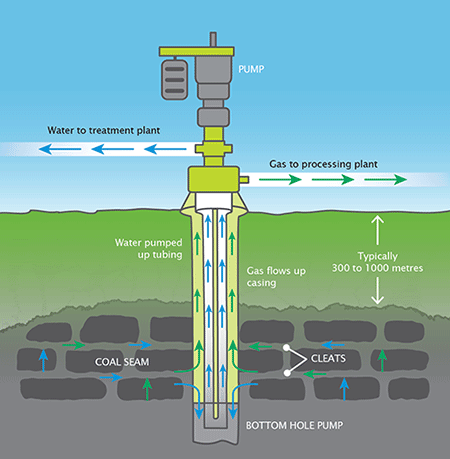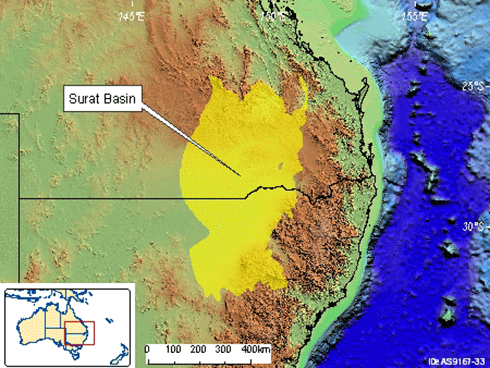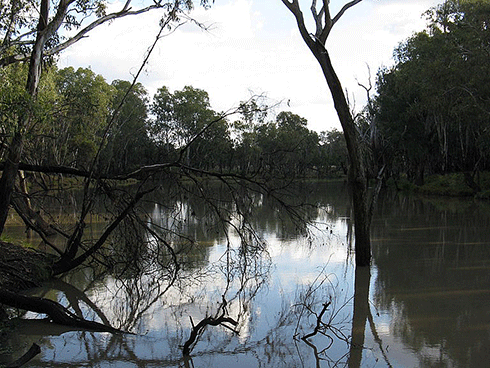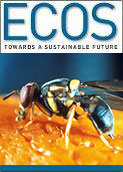
|
Published: 11 November 2013
Measuring methane seeps in the Surat Basin
With methane holding 28 times the warming potential of carbon dioxide, any increase in emissions is cause for concern. Recently, attention has focused on methane seepage associated with coal seam gas extraction.
Yet our understanding of how to identify natural background methane emission levels and track ‘fugitive’ emissions associated with leakages from gas infrastructure remains limited. A new CSIRO study into methane emissions in the Surat Basin gas fields should provide much-needed clarity.
Coal seam gas (CSG) extraction is an emotive issue, with public concerns over the potential long-term impacts of the extraction process leading to the formation of community alliances like ‘Lock the Gate’ and their well-publicised clashes with gas-company representatives and the police.
Those public concerns have focused on reduced groundwater levels and risks to groundwater quality, as well as impacts on local waterways, agriculture and other land uses, increased methane emissions and wastewater management.
In 2012, residents living near the spring-fed Condamine River, near Chinchilla in Queensland noticed the river bubbling like a spa. The Condamine lies in the 1.7 million-square-kilometre Surat Basin. Since the mid-1990s, coal seam gas (CSG) has been extracted from the western part of the basin near Roma.
CSG supplies up to 20 per cent of Brisbane’s domestic energy needs and, in the past two years, new production fields have opened up to support export from Curtis Island in Gladstone.
Last year, when local residents noticed the bubbling in the Condamine, they called on Dr Gavin Mudd, a senior lecturer at the Department of Civil Engineering, Monash University, who studies sustainability issues around resource extraction.
According to Dr Mudd, it’s hard to know how concerned the public should be, because it’s not known whether the methane seepage was produced by natural processes or by CSG extraction.
‘Locals had never seen the Condamine bubbling before, and residents were concerned that it was being caused by depressurisation of coal seams to get gas out, allowing it to flow into places it’s never been before,’ he says.
‘We have to ask, what else might be bubbling to the surface?’
CSG 101
‘It is not unusual to find methane seeping to the atmosphere in these regions, because it naturally occurs in sedimentary basins that contain coal,’ says Dr Damian Barrett, Stream Leader of the Water in the Resources Sector at CSIRO’s Water for a Healthy Country Flagship, and an adjunct professor at Centre for Water in the Minerals Industry at the University of Queensland.
Methane migrates to the surface via pore spaces in layers of rock and overburden, or in fissures, cracks and outcrops of geological layers that connect with the coal seam. The amount of gas escaping to the atmosphere can vary over time because of changing groundwater levels. It is thought that, globally, around 60–80 million tonnes of methane naturally seep into the atmosphere each year from geological sources.
CSG extraction requires the drilling of wells to reach coal seams, which lie at a depth of around 300–1000 metres. The initial phase of CSG extraction usually involves pumping groundwater from the coal seams in order to reduce the water pressure and release gas from the coal. At the surface, water in the gas is separated and piped elsewhere for use or further treatment.
‘When wells are established, the aim is to increase the surface area of the well bottom that is in the coal seam to improve gas flow. Some wells may also be hydraulically fractured to improve gas flow,’ says Dr Barrett.

|
|
The coal seam gas extraction process. Credit:
CSIRO
|
The more common term used for hydraulic fracturing – fracking – has been at the centre of many public objections to CSG extraction.
Yet, at the moment, hydraulic fracturing is used far less commonly in CSG extraction than in shale gas extraction. When applied to CSG, it uses around one-fifth the water required to hydraulically fracture shale rock – which can involve 20–25 million litres of water being injected into a well to fracture the shale beds.
‘[Hydraulic fracturing] is basically a method used to stimulate the flow of gas to well heads,’ Dr Barrett explains. ‘It is most commonly used in shale gas extraction, which occurs at great depth, although it is used occasionally in coal seam gas production.
‘Shale has a porosity around a million times less than sand on a beach. The gas won’t flow unless the shale is fractured.’
In the Surat, CSG extraction occurs via vertical wells, drilled to depths of hundreds of metres. Only one well is drilled per pad, unlike shale gas, which uses much deeper and longer wells and has been associated with land damage and claims of waterway pollution in the US.
Dr Barrett says that at this stage less than 10 per cent of wells in the Surat have been hydraulically fractured.
‘However, as gas production slows, companies might also go back and fracture. We estimate that there is the potential for between 10 and 40 per cent of wells to be hydraulically fractured.’
Baseline study
What about the gas bubble ‘spa’ in the Condamine? Dr Mudd believes it is unlikely to present a great risk to the river’s water quality, but if methane is suddenly escaping into the river, there may be other things going on as well. The potential impact on climate change can’t be overlooked either.
‘There are no bores being monitored in the areas where the river is bubbling, and no other monitoring to identify the cause of the methane release,’ he says.
‘We don’t know how much leakage is occurring because there were no baseline studies done, and industry is not measuring adequately. We need to measure air and soil fluxes and monitor groundwater.
‘Other studies have been done on groundwater but they missed these critical aspects.
‘CSG is a diffuse resource and uses lots of bores over a large area to extract it. Conventional gas extraction uses a more concentrated structure, meaning you don’t need as many bores. If there are fugitive emissions coming from infrastructure or other sources, then more bores will mean more seals to check.
‘If we try to work it out now, it can’t be done, because there have been no baseline studies prior to extraction.’
A new study by CSIRO, and supported by the Gas Industry Social and Environmental Research Alliance (GISERA), is aimed at resolving that. The study is measuring methane seeps inside the Surat Basin gas fields.
‘The project will help us understand the background (natural) methane emissions from the Surat Basin seeping to the surface and escaping to the atmosphere as well as any natural variability,’ says Dr Barrett.
‘If methane levels remain constant, then it doesn’t present a new problem in terms of warming, but we need to understand these background emissions because if methane emissions increase then we will see increased warming.’
He says that, while he wouldn’t necessarily expect impacts from commercial methane production on background seeps, ‘we need to be sure and to establish a baseline that can be used over the next decade’.

|
|
The Surat Basin. Credit:
Geoscience Australia
|
The project is in its early stages and will involve three phases: a background review, pilot study, and finally establishment of background fluxes.
‘Because of the distributed nature of methane seeps across the basin, it is not possible to buy a set of instruments to get all of the answers we want,’ says Dr Barrett.
‘So we will need to bring together a range of technologies including remote sensing, isotopic analysis and atmospheric “top-down” methods to understand how concentrations vary under different wind and other conditions.’ When there is little wind, for example, methane fluxes can be measured more accurately, but when it’s windy, the gas disperses.
By understanding background methane emissions, it will be easier for scientists to understand fugitive methane emissions from infrastructure such as pipes and wellheads, explains Dr Barrett.
‘Whether methane seeps increase or decrease depends also on pressure gradients and directions of flow. If you lower pressure in coal seams and pressure flows to wellheads, we might see a reduction in methane seepage because when it flows to the wellhead it is captured instead of seeping.
‘The aim of the study is to find out.’
Safety first
As already noted, Dr Barrett was not surprised by the appearance of a ‘spa’ in the Condamine.
‘The Surat Basin runs from Toowoomba in the east, past Roma, and dips and deepens to the west. The Condamine River lies in the basin’s east, where the Walloon Coal Measures – which is the formation targeted for CSG extraction – intersects with the Condamine alluvium and outcrops to the west of the river.
‘It makes sense that methane would bubble up to the surface here.’
However, Dr Mudd remains sceptical about the value of tracking emissions after CSG extraction has commenced.
‘If we think about food production or car safety, both of which have the potential to impact human health, they are forced to pass through rigorous safety testing, before, not after, being used.
‘Why isn’t it the same for environmental health?’




